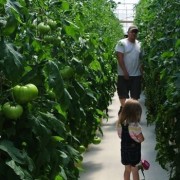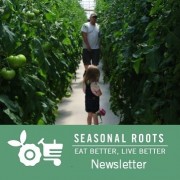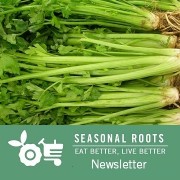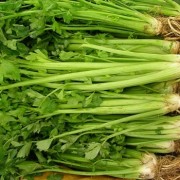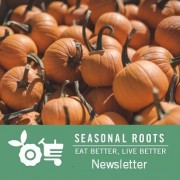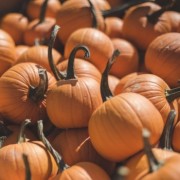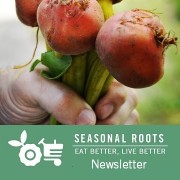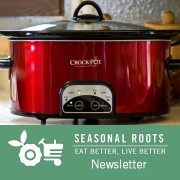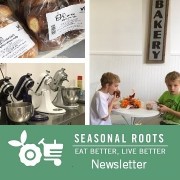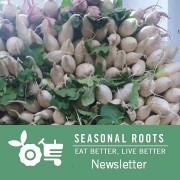Which is best?!
–
By the Seasonal Roots Veggie Fairy Team
We get this question pretty often: “So are your farms Certified Organic?”
When people ask that, we totally get where they’re coming from. We all just want to eat nutritious, safe, non-toxic, eco-friendly food. But who has time to research every item we buy? So the government’s “Certified Organic” label seems like a convenient shortcut to eating healthy without harming the planet.
If only it were true.
Organic vs sustainable vs local… how do you decide which is best? Here at Seasonal Roots, we’re more concerned about sustainable and local than organic, so we don’t require our local farmers to be Certified Organic.
Here are 4 reasons why.
1. “Organic” doesn’t equal “locally grown”.
In fact, it may even be grown in a foreign country and shipped to the U.S. The result? A bigger carbon footprint. That’s not eco-friendly.
There’s actually no standard definition for “local”. Our standard is within about 150 miles of our delivery areas in Virginia. So most of our local partners are in Virginia. A few are in southern Pennsylvania or Maryland or eastern North Carolina.
To maintain a healthy variety of options during the winter, we partner with sustainable farmers in Florida. We call that produce “regional” because it can get to us within a day of harvest without resorting to flying. Members who prefer to eat only what’s in season locally can opt out of our winter-time regional offerings.
2. Organic doesn’t equal nutritious, either.
The sooner produce gets to you the better.
Research shows that most nutrients begin to degrade from the moment produce is harvested. Spinach, for example, loses up to 60% of its nutrients in a week, the typical age of most grocery store produce. Our local produce gets to you within just a couple days of harvest.
Also, many studies have found that fruit that’s picked closer to the peak of ripeness (rather than being picked green and ripening on the shelf or by being gassed) contains more nutrients, more vitamins and minerals, than fruit that’s picked before or after peak, whether it’s organic or not.
This is why we hustle to get your produce to you as soon as possible after harvesting, and why being local helps — it doesn’t have to travel very far. Much of the food in grocery stores has traveled thousands of miles and many days to get there, losing nutrients every hour of the way.
3. Organic is no guarantee of food safety.
That organic label can’t tell you whether
the food was produced under clean and healthy conditions. Plus, Certified Organic farmers can still use herbicides and pesticides – just certified organic ones. While this changes the mix of what’s sprayed, it doesn’t make it better, and they often spray frequently as a matter of course.
Our local farmers are low- or no-spray. Many of them are multi-generational, so they care for their land, crops, and animals with the next generation in mind. They use sustainable practices like rotating their crops to avoid sucking all the nutrients out of the soil. The vast majority of our farmers don’t spray because that would jeopardize the integrity of their land. If they do spray, it’s minimal and only as required. You could call sustainable farming “old school organic”, the way it was often done before the government got in the business of regulating it.
One of our sustainable farmers has a friend who runs a Certified Organic farm not far from him. One year, our sustainable farmer sprayed his yellow squash one time all season because it was necessary. His Certified Organic friend, on the other hand, sprayed his squash on a weekly schedule using a spray approved by the USDA. Our farmer isn’t considered Certified Organic, but his weekly spraying friend is allowed to use that title.
4. The best way to know if your food is nutritious, eco-friendly, and safe is to know your farmer.
That’s not possible for most of us as individuals. But when we come together as a group like Seasonal Roots, that’s exactly what we do. We know our farmers. We talk with them, visit their farms, and develop relationships with them.
We share their stories with you so you can know them too, even if you don’t have time to go visit them yourself. It’s not quite as easy as the “Certified Organic” shortcut, but it’s a lot easier than trying to do it all by yourself.
We support our local farmers because we know and trust them and their practices. They produce safe food for their families, our families. and your families. So whether you just celebrated Halloween or simply enjoy the season’s produce, sustainably grown local food (like the pumpkins pictured here) is better for you and better for the planet!
ABOUT SEASONAL ROOTS
Since 2011, Seasonal Roots’ online farmers market has connected Virginia families with local family farmers who use sustainable, humane practices. Our veggie fairies – mostly moms who believe in living better through scrumptious, healthy eating, being kind to animals, protecting the environment, and spreading joy – home-deliver freshly harvested produce, eggs, grass-fed dairy and meat, plus artisan fare. We empower our members to eat better and live better with more nutritious, flavorful food that’s good for us and good for the planet. More info at seasonalroots.com.
